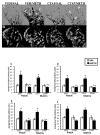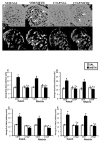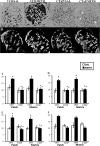Methamphetamine-induced stereotypy correlates negatively with patch-enhanced prodynorphin and arc mRNA expression in the rat caudate putamen: the role of mu opioid receptor activation
- PMID: 20298714
- PMCID: PMC2892833
- DOI: 10.1016/j.pbb.2010.02.019
Methamphetamine-induced stereotypy correlates negatively with patch-enhanced prodynorphin and arc mRNA expression in the rat caudate putamen: the role of mu opioid receptor activation
Abstract
Amphetamines induce stereotypy, which correlates with patch-enhanced c-Fos expression the patch compartment of caudate putamen (CPu). Methamphetamine (METH) treatment also induces patch-enhanced expression of prodynorphin (PD), arc and zif/268 in the CPu. Whether patch-enhanced activation of any of these genes correlates with METH-induced stereotypy is unknown, and the factors that contribute to this pattern of expression are poorly understood. Activation of mu opioid receptors, which are expressed by the neurons of the patch compartment, may underlie METH-induced patch-enhanced gene expression and stereotypy. The current study examined whether striatal mu opioid receptor blockade altered METH-induced stereotypy and patch-enhanced gene expression, and if there was a correlation between the two responses. Animals were intrastriatally infused with the mu antagonist CTAP (10 microg/microl), treated with METH (7.5 mg/kg, s.c.), placed in activity chambers for 3h, and then sacrificed. CTAP pretreatment attenuated METH-induced increases in PD, arc and zif/268 mRNA expression and significantly reduced METH-induced stereotypy. Patch-enhanced PD and arc mRNA expression in the dorsolateral CPu correlated negatively with METH-induced stereotypy. These data indicate that mu opioid receptor activation contributes to METH-induced gene expression in the CPu and stereotypy, and that patch-enhanced PD and arc expression may be a homeostatic response to METH treatment.
Copyright 2010 Elsevier Inc. All rights reserved.
Figures






Similar articles
-
Blockade of patch-based μ opioid receptors in the striatum attenuates methamphetamine-induced conditioned place preference and reduces activation of the patch compartment.Eur J Pharmacol. 2017 Feb 5;796:207-214. doi: 10.1016/j.ejphar.2017.01.001. Epub 2017 Jan 3. Eur J Pharmacol. 2017. PMID: 28057490 Free PMC article.
-
Striatal patch compartment lesions alter methamphetamine-induced behavior and immediate early gene expression in the striatum, substantia nigra and frontal cortex.Brain Struct Funct. 2014 Jul;219(4):1213-29. doi: 10.1007/s00429-013-0559-x. Epub 2013 Apr 27. Brain Struct Funct. 2014. PMID: 23625147 Free PMC article.
-
Activation of mu opioid receptors in the striatum differentially augments methamphetamine-induced gene expression and enhances stereotypic behavior.J Neurochem. 2012 Mar;120(5):779-94. doi: 10.1111/j.1471-4159.2011.07620.x. Epub 2012 Jan 23. J Neurochem. 2012. PMID: 22150526 Free PMC article.
-
Regulation of psychostimulant-induced preprodynorphin, c-fos and zif/268 messenger RNA expression in the rat dorsal striatum by mu opioid receptor blockade.Eur J Pharmacol. 2006 Feb 17;532(1-2):61-73. doi: 10.1016/j.ejphar.2005.12.041. Epub 2006 Jan 27. Eur J Pharmacol. 2006. PMID: 16443216
-
Effect of methamphetamine neurotoxicity on learning-induced Arc mRNA expression in identified striatal efferent neurons.Neurotox Res. 2008 Dec;14(4):307-15. doi: 10.1007/BF03033855. Neurotox Res. 2008. PMID: 19073434 Free PMC article.
Cited by
-
Striatal patch compartment lesions reduce stereotypy following repeated cocaine administration.Brain Res. 2015 Aug 27;1618:286-98. doi: 10.1016/j.brainres.2015.06.012. Epub 2015 Jun 19. Brain Res. 2015. PMID: 26100338 Free PMC article.
-
Blockade of patch-based μ opioid receptors in the striatum attenuates methamphetamine-induced conditioned place preference and reduces activation of the patch compartment.Eur J Pharmacol. 2017 Feb 5;796:207-214. doi: 10.1016/j.ejphar.2017.01.001. Epub 2017 Jan 3. Eur J Pharmacol. 2017. PMID: 28057490 Free PMC article.
-
Striatal patch compartment lesions alter methamphetamine-induced behavior and immediate early gene expression in the striatum, substantia nigra and frontal cortex.Brain Struct Funct. 2014 Jul;219(4):1213-29. doi: 10.1007/s00429-013-0559-x. Epub 2013 Apr 27. Brain Struct Funct. 2014. PMID: 23625147 Free PMC article.
-
Brain Histamine N-Methyltransferase As a Possible Target of Treatment for Methamphetamine Overdose.Drug Target Insights. 2016 Mar 2;10:1-7. doi: 10.4137/DTI.S38342. eCollection 2016. Drug Target Insights. 2016. PMID: 26966348 Free PMC article. Review.
-
Activation of mu opioid receptors in the striatum differentially augments methamphetamine-induced gene expression and enhances stereotypic behavior.J Neurochem. 2012 Mar;120(5):779-94. doi: 10.1111/j.1471-4159.2011.07620.x. Epub 2012 Jan 23. J Neurochem. 2012. PMID: 22150526 Free PMC article.
References
-
- Adams AC, Layer RT, McCabe T, Keefe KA. Effects of conanotoxins on L-3-4-dihydroxyphenylalanine-induced behavior and immediate early gene expression. Eur J Pharmacol. 2000;404:303–313. - PubMed
-
- Adams DH, Hanson GR, Keefe KA. Differential effects of cocaine and methamphetamine on neurotensin/neuromedin N and preprotachykinin messenger RNA expression in unique regions of the striatum. Neuroscience. 2001;102:843–851. - PubMed
-
- Adams DH, Hanson GR, Keefe KA. Distinct effects of methamphetamine and cocaine on preprodynorphin messenger RNA in rat striatal patch and matrix. J Neurochem. 2003;84:87–93. - PubMed
-
- Bolam JP, Izzo PN, Graybiel AM. Cellular substrate of the histochemically defined striosome and matrix system of the caudate nucleus: a combined golgi and immunohistochemical study. Neuroscience. 1988;24:853–875. - PubMed
-
- Canales JJ, Graybiel AM. A measure of striatal function predicts motor stereotypy. Nat Neurosci. 2000;3:377–383. - PubMed
Publication types
MeSH terms
Substances
Grants and funding
LinkOut - more resources
Full Text Sources
Medical
Research Materials

